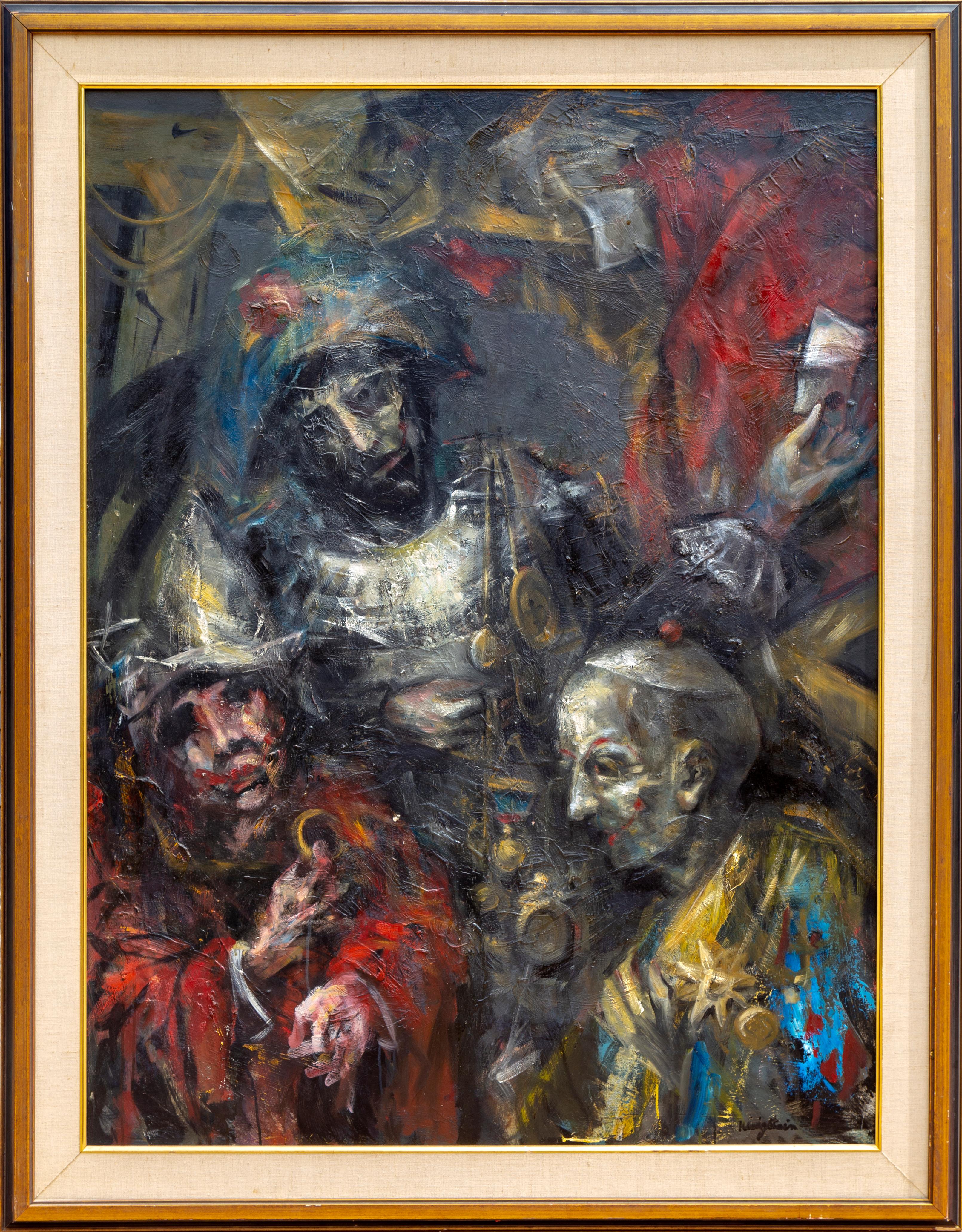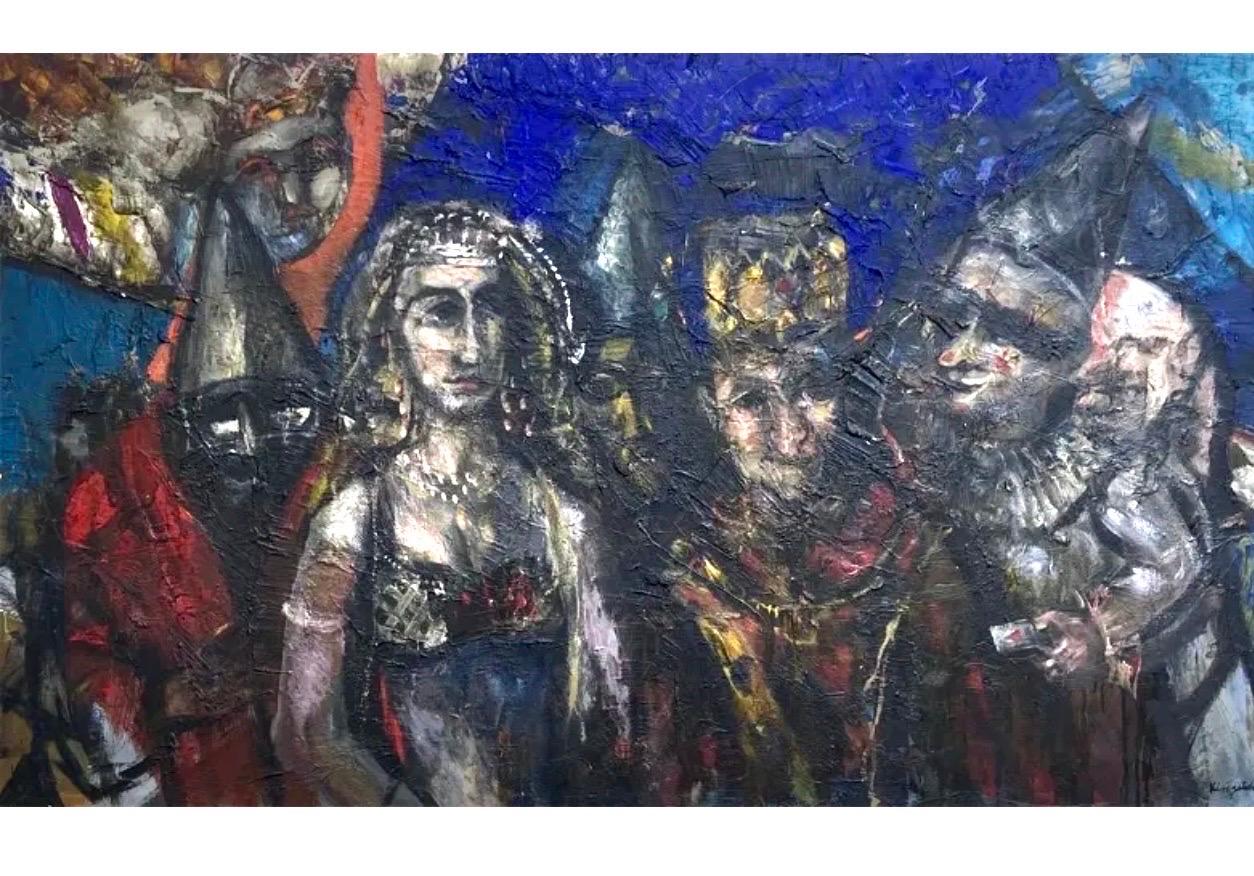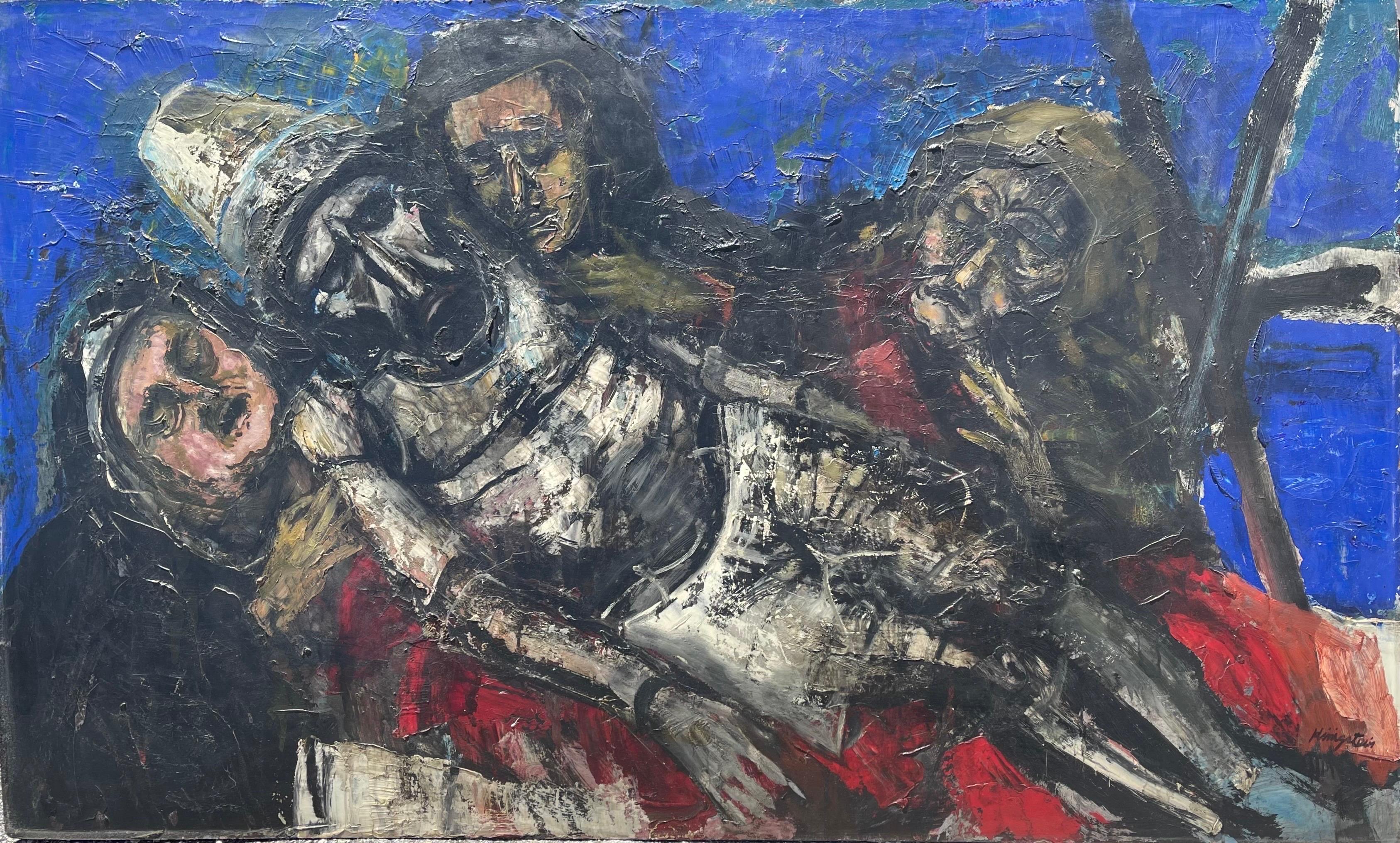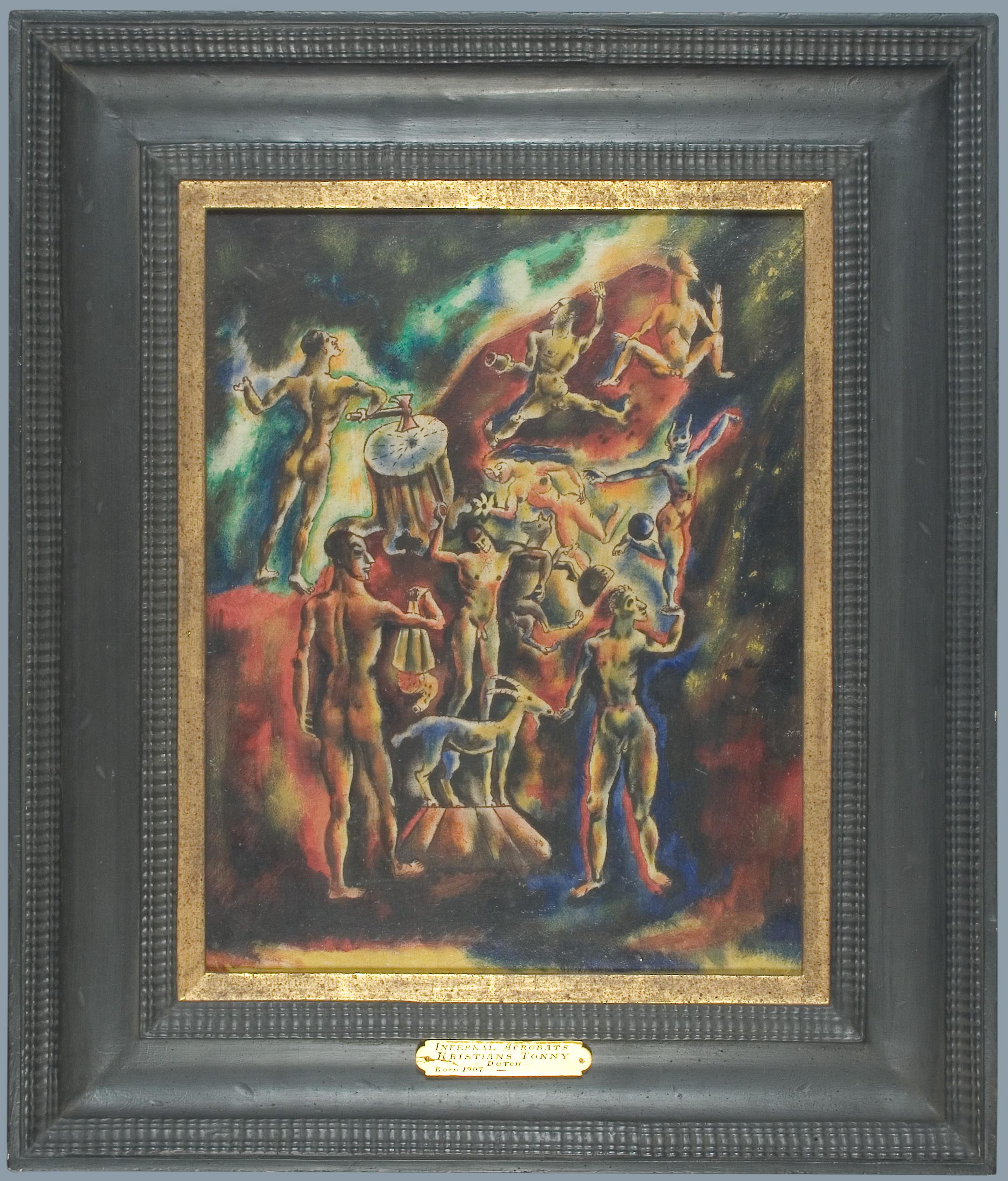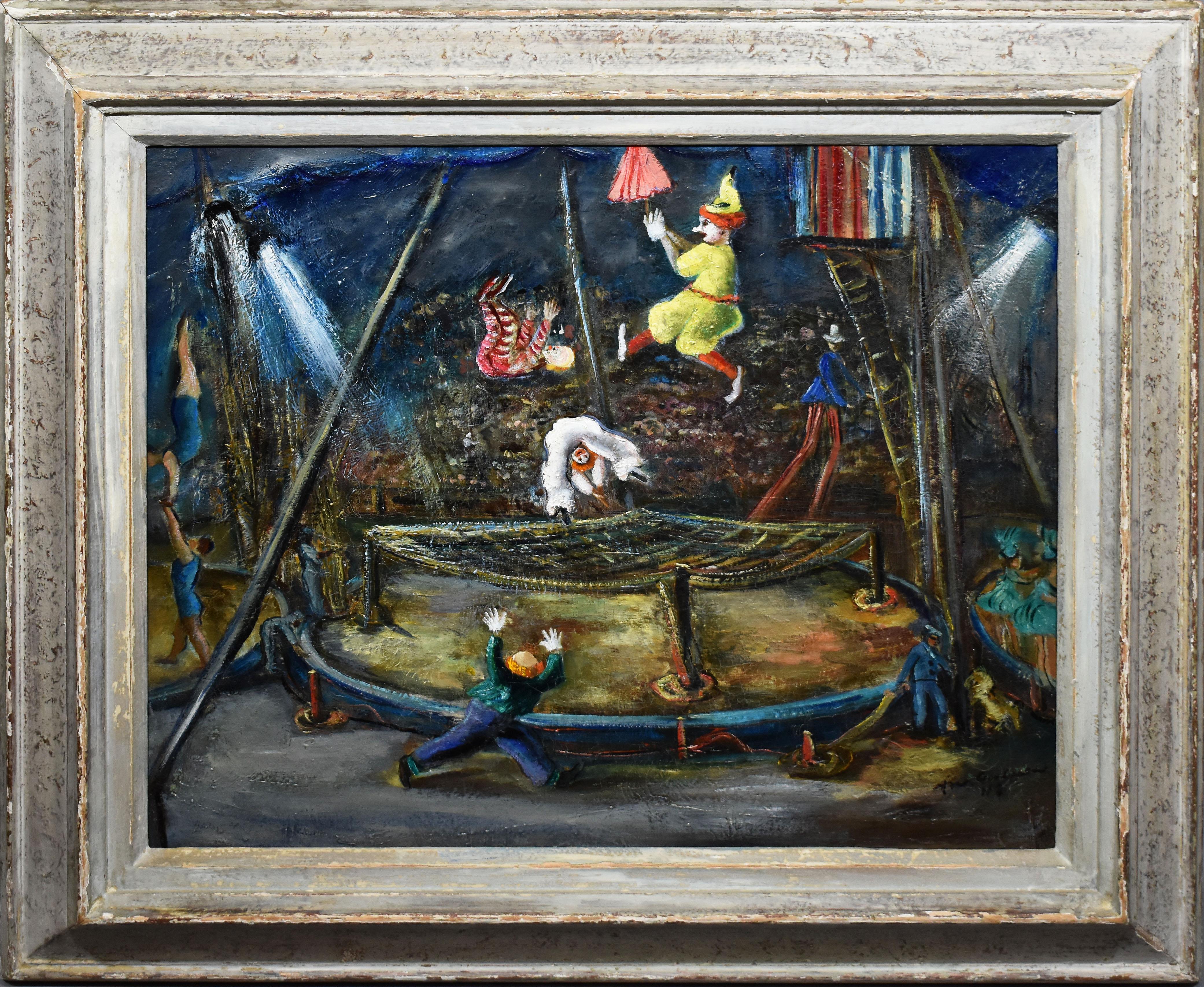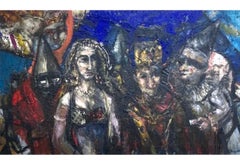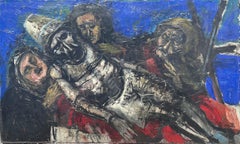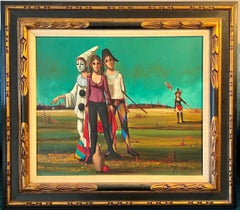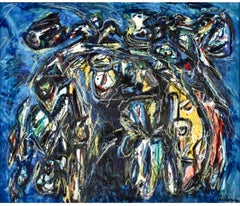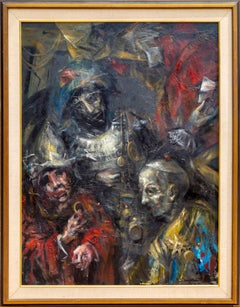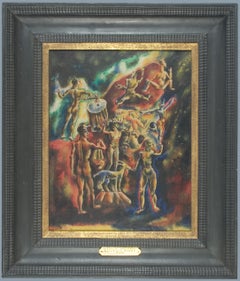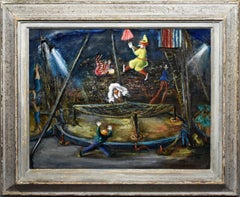Items Similar to Large Oil Painting Circus Scene Clowns Rediscovered NY Artist Jonah Kinigstein
Want more images or videos?
Request additional images or videos from the seller
1 of 19
Jonah KinigsteinLarge Oil Painting Circus Scene Clowns Rediscovered NY Artist Jonah Kinigsteinc. 1950s
c. 1950s
$4,500
£3,391.73
€3,920.24
CA$6,358.48
A$6,950.04
CHF 3,660.42
MX$85,457.48
NOK 45,745.17
SEK 43,037.17
DKK 29,266.98
About the Item
Jonah Kinigstein
"Death of a Clown"
Large Oil on Board Painting of macabre circus scene with clowns
Hand signed lower left and signed and titled verso
Frame: 55 X 43 Image: 48 X 36
Jonah Kinigstein (b. 1923) is a National Academy artist from Coney Island. An American Postwar & Contemporary painter. He works in a figurative expressionist style. His works are featured in the Smithsonian American Art Museum, the National Academy of Design, the Whitney Museum of American Art, and the Museum of Modern Art in New York. He lives in New York City. Jonah Kinigstein was trained at Cooper Union Art School, The Grande Chaumiere in Paris; and Belle Arte in Rome. He has been a Fulbright Fellow. He has holdings at MOMA, the Ain Herod Museum in Tel Aviv; Smithsonian; the Albright-Knox Gallery and the Nelson Gallery of Art. He lived and worked in Brooklyn New York. Kinigstein was inducted as an Academician into the National Academy of Design in 1997.
Exhibits include: Young Americans at the Whitney Museum of American Art; the National Academy of Arts and Letters; ACA Gallery; Rittenhouse Gallery; the Washington Irving Gallery; and the Pindar Gallery.
Contemporary American Painting and Sculpture (CAPS) '59, University of Illinois, Arthur Okamura, Fred Farr, Jonah Kinigstein, Lawrence Calcagno, Reuben Tam and Rico Lebrun.
Jonatha Kinigstein attended The Cooper Union and Grand Chaumiere, Paris. He received a Fulbright scholarship to study in Rome, and has also received awards from the Butler Art Institute; American Academy of Arts and Letters; Silvermine Guild; and Louis Comfort Tiffany Foundation. Kinigstein has had solo shows at Galerie Bretau, Paris; Alan Gallery, Grippi Gallery, ACA Gallery, and Pindar Gallery, New York; Siembab Gallery, Boston; Rittenhouse Gallery, Philadelphia; among others. His work is in the collections of the Whitney Museum of American Art; Museum of Modern Art; Allentown Art Museum; Albright Art Gallery; Butler Art Institute; and more. He has taught at the Brooklyn Museum and National Academy of Design School of Fine Arts.
Born in 1923 in Coney Island, Jonah’s early influences were discovered during visits to the Metropolitan Museum- “When I really saw the old masters, it blew my mind, of course.” He attended Cooper Union for a year before he was drafted into the Army, serving from 1942 – 1945. Soon after, Jonah moved to Paris where he spent time at the Académie de la Grande Chaumière, conversing with other aspiring artists, exchanging ideas, exhibiting his work, seeing established artists, and generally soaking up a fertile creative environment. He exhibited in several shows including the Salon D’Automne, Salon de Mai, and the Salon des Moins de Trente Ans, and had one-man shows in the Galerie Breteau and Les Impressions D’Art. After Paris, Jonah moved to Rome on a Fulbright Scholarship and studied at the La Schola Di Belles Artes. After a year, he returned to the U.S. and exhibited his paintings at the Downtown Gallery in Manhattan. A classically trained painter whose ambitions were frustrated by the New York art world’s obsession with Abstract Expressionism and the lucrative industry that grew up around it. Like so many painters, he was unable to make a living solely from painting, so he worked in the commercial art world and did freelance illustration and design. Throughout this time, Jonah’s commitment to his own art never wavered, and he continued to paint and occasionally exhibit. He was included in the MoMA show, Summer Exhibition: New Acquisitions; Recent American Prints, 1947–1953; Katherine S. Dreier Bequest; Kuniyoshi and Spencer; Expressionism in Germany; Varieties of Realism along with Alexander Archipenko, Francis Bacon, Balthus, Will Barnet, Leonard Baskin, Eugene Berman, Reg Butler, Lovis Corinth, Andre Derain, Otto Dix, Raoul Dufy, Max Ernst, Lucian Freud, George Grosz, Alexei Jawlensky, Oskar Kokoschka, Roberto Matta, Man Ray, Marcel Duchamp and more.
The most comprehensive collection of paintings by the noted satirist and cartoonist Jonah Kinigstein Unrepentant Artist features over a hundred paintings that “discover the most repulsive absurdities and abnormalities in the world as a whole — in human existence as such” (from Barry Schwabsky’s introduction). Kinigstein’s portrait and landscape paintings and satirical cartoons. An art-world pariah most of his life, he’s become an unlikely star at age 92, with an acclaimed exhibition of his savagely satirical cartoons at the Society of Illustrators in New York and a new book from comics powerhouse Fantagraphics that shares its title, “The Emperor’s New Clothes: The Tower of Babel in the ‘Art’ World. “ As that name attests, Kinigstein’s work rips into what he sees as the vapidity, pretension and inanity of 20th-century modern art, from institutions like MoMA to gallerists like Ilona Sonnabend to critics like Clement Greenberg. Sacred-cow abstract expressionist artists — Willem de Kooning, Jackson Pollock, Jasper Johns – don’t escape his poison pen, either. “I put the cartoons up on walls all over Soho,” he says. “I really gave these people the business. And I got a lot of pushback. Some people wanted to fight with me.” They’d have a tough adversary. Kinigstein was born in the Bronx and raised on East Tremont Avenue in one of the borough’s rougher sections. His family was Jewish, but not especially religious; “we had Passover Seders, things like that,” he says. He studied architecture and painting at Cooper Union, which was still free at the time for deserving students. After serving in the Army as a photographer, Kinigstein bolted for Paris and Rome, where he studied art on a Fulbright scholarship and exhibited his paintings. He was included in the prestigious exhibition Contemporary American Painting and Sculpture held at the University of Illinois at Urbana-Champaign in 1955. The exhibition featured works by prominent American artists of the time including artists Josef Albers, Milton Avery, Louise Bourgeois, Stuart Davis, Adolph Gottlieb, Hans Hoffmann, Robert Motherwell, Georgia O'Keefe, Ben Shahn, Yves Tanguy, and Dorothea Tanning. The exhibition was part of the University of Illinois's Festival of Contemporary Arts. It was a snapshot of the art scene in 1955. Back in the U.S., Kinigstein’s figurative work found a following, until it didn’t; as more diffuse art forms took over, his style fell out of favor among art-world gatekeepers. “There was no interest in figurative art or what I had to say,” he remembers. To support himself, he launched a career in advertising and commercial illustration, drawing and painting on the side. “I’m really a painter. The cartoons came later,” he says. “I had to do something to clear the air.”
Eventually, Kinigstein sent his cartoons to Fantagraphics, where they lay in the office of publisher Gary Groth for five years. When Groth finally got around to opening Kinigstein’s mailing tube, he was blown away. “It was savage, contrarian work,” Groth says in the short film that accompanies Kinigstein’s MoCCA exhibition. The cartoons – which draw inspiration from classic satirical cartoonists like William Hogarth, James Gillray, and George Cruickshank — have been collected in a handsome 80-page volume that lands this month. Not everyone in the art world gets darts from Kinigstein. “I never lost interest in Pablo Picasso,” he says. “He was always figurative.” Kinigstein pointed to the packed walls of the Society of Illustrators’ gracious third-floor restaurant, where he spoke with the Forward. In the meantime, Kinigstein seems to be enjoying his belated moment in the sun. He’s even slated to lecture this spring at Parsons the New School for Design, the temple of art education in New York.
- Creator:Jonah Kinigstein (1923, American)
- Creation Year:c. 1950s
- Dimensions:Height: 55 in (139.7 cm)Width: 43 in (109.22 cm)
- Medium:
- Movement & Style:
- Period:
- Condition:Minor wear to frame. Please see photos.
- Gallery Location:Surfside, FL
- Reference Number:1stDibs: LU38216673922
About the Seller
4.9
Platinum Seller
Premium sellers with a 4.7+ rating and 24-hour response times
Established in 1995
1stDibs seller since 2014
1,806 sales on 1stDibs
Typical response time: <1 hour
- ShippingRetrieving quote...Shipping from: Surfside, FL
- Return Policy
Authenticity Guarantee
In the unlikely event there’s an issue with an item’s authenticity, contact us within 1 year for a full refund. DetailsMoney-Back Guarantee
If your item is not as described, is damaged in transit, or does not arrive, contact us within 7 days for a full refund. Details24-Hour Cancellation
You have a 24-hour grace period in which to reconsider your purchase, with no questions asked.Vetted Professional Sellers
Our world-class sellers must adhere to strict standards for service and quality, maintaining the integrity of our listings.Price-Match Guarantee
If you find that a seller listed the same item for a lower price elsewhere, we’ll match it.Trusted Global Delivery
Our best-in-class carrier network provides specialized shipping options worldwide, including custom delivery.More From This Seller
View AllLarge Figurative Expressionist Oil Painting Rediscovered New York City Artist
By Jonah Kinigstein
Located in Surfside, FL
King and queen with clowns and jesters. Bold, colorful, expressionist masterful painting.
Jonah Kinigstein (b. 1923) is an American Postwar & Contemporary painter. He works in a fig...
Category
20th Century Expressionist Portrait Paintings
Materials
Oil, Board
Large Figurative Expressionist Oil Painting Rediscovered New York City Artist
By Jonah Kinigstein
Located in Surfside, FL
Jonah Kinigstein (b. 1923) is an American Postwar & Contemporary painter. He works in a figurative expressionist style. His works are featured in the Smithsonian American Art Museum,...
Category
20th Century Expressionist Portrait Paintings
Materials
Oil, Board
French Mod Surrealist Commedia dell'arte Circus Scene Oil Painting J.P. Serrier
By Jean Pierre Serrier
Located in Surfside, FL
Jean Pierre Serrier (French, 1934-1989)
Oil on canvas painting depicting four figures
Hand signed lower right.
Measures (frame) 26.5" x 30" wide, and (sight) 18.25." x 22.25" wide.
Jean Pierre Serrier (1934 – 1989) was a French painter known for surrealism and absurdist art. Jean-Pierre Serrier was born in Montparnasse, Paris and attended the Académie des Beaux-Arts in Paris.
the son of Louis and Solange Serrier. His father fought in World War II and became a prisoner of war. In 1940, as a six-year-old, he and his mother fled Paris for Corrèze in southwest France. Childhood memories of close escapes from German bombardments would later influence his absurdist philosophy of life. Passionate about drawing, in 1951 he applied and was admitted to the École nationale supérieure des arts appliqués et des métiers d'art in Paris. He shared an attic apartment in the 16th arrondissement with fellow student Jean-Baptiste Valadié. For income, he decorated shop windows. A trip to Spain provided motifs for early works. His student work might be characterized as art naïf (Naive art). While still a student, he sold a ceramic artwork to the poet and publisher Pierre Seghers, who would later commission drawings from him. He frequented jazz clubs in Saint-Germain des Près, and while listening to Sidney Bechet at the Vieux Colombier, he met his wife, Yvette.One of the last French Surrealist and follower of Nietzsche. His art conveyed the message to all of mankind that we are only human. The other Surrealist to center his art in philosophy was Rene Magritte whose paintings reflect his understanding of Sigmund Freud. He had his first exhibition in 1955, before being sent to Algeria to complete his military service. After graduating in 1955, he was drafted for military service, spent time in Germany and Morocco, and was sent to the front lines of the Algerian War. In 1959 he exhibited works at two Parisian galleries and at Juan-les-Pins on the Côte d'Azur. From 1961, he exhibited annually at the Salon des Artistes Français. In 1962, the City of Paris purchased his painting Un dimanche In 1961, Serrier made his first visit to the United States to exhibit at a New York gallery. In 1975 and 1979, he had successful exhibitions in New Orleans, and his work was included in art and news magazines, including Time and Newsweek.
Beginning in the 1950s, his works included stylized portraits similar in some ways to the "big eyes" art of Margaret Keane, though it is uncertain that either artist influenced the other. Keane painted children, and so did Serrier, sometimes from life, but Serrier’s models are usually somewhat older, though uniformly slender and with androgynous features.
A gallery owner introduced Serrier to American collectors Edgar Garbisch and his wife, Bernice Chrysler (daughter of Chrysler founder Walter P. Chrysler), who had a particular interest in naïve art; they commissioned a series of portraits from Serrier. At the same time, he met Reine Ausset in Paris, who in 1961 invited him to New York to take part in an exhibition at Galerie Norval on 57th Street. The show also included work by Moïse Kisling, and the exhibition program explicitly linked the two artists, saying that Serrier, who considered Moise Kisling "the Master," had found his own technique, but "the same vision joins the grand Kisling to the young Serrier: plenitude of shapes, sureness of palette, precision in outlines."
In the 1960s he began painting slender, young, androgynous figures in groups, set in sparse landscapes with suggestions of the surreal and sometimes wearing costumes of the Commedia dell'arte. In some of these paintings the eyes of the figures are completely black, a motif that would continue in his later work. In 1965, he exhibited at Forest and Reed Gallery in London. Also in 1965, he discovered the small town of Martel, and with his old roommate Jean-Baptiste Valadié purchased a house that they opened as the gallery La Licorne (The Unicorn) in 1967.
Responding to the political upheavals of May 1968 in France, and following the advice of Geneva gallery owner Roger Ferrero, Serrier's work became increasingly complex, idiosyncratic, and surreal. Imagery included the Tower of Babel, bodies suspended in space, and crowds of people all dressed alike, with identical features and entirely black eyes. Mannequins, playing cards, nudes, and levitating orbs also figured in the work. In a nod to Magritte, his men sometimes wear bowler hats. Another influence may have been the works of the Franco-Belgian surrealist Gaston Bogaert (1918-2008). Serrier's first major exhibit of these works, in Geneva in 1971, was titled Le Réalisme Fantastique. (Magic Realism)
In 1972, he was made a member of the Société du Salon d'Automne, under whose auspices he was invited by the Polish government to exhibit in Warsaw in 1973, as part of a cultural exchange across the Iron Curtain. In 1976, he served on the jury of the Salon d'Automne.
In 1975, New Orleans gallery owner Kurt E. Schon brought his work to several cities in the United States. A copiously illustrated monograph in English, Surrealism and the Absurd: Jean Pierre Serrier, was published in 1977. Author Thomas M. Bayer wrote: Serrier's world is one where—to use Friedrich Nietzche's term—the "human herd animal" is being confronted with the overwhelming task of coping with the world, his solitude, and at times, his resignation in the face of its monstrous size and duration. It is a world where the characterless, "blind" man faces the institutions, rules and symbols that made him into the being he now is…But Serrier does not lose himself in this world he portrays. He never forgets the old French tradition, the "black" humor, à la Molière. This classical humor at times is more felt than seen, in a manner that can be terribly funny, because it is horrifying, laughable, poignant and always true. Serrier told a friend, "In each of my paintings there's a message of hope amid the crowd of stereotypical figures. It could be an escaping dirigible, or a nymphet who flees like a deer under the red and blue trees of paradise...
Category
Mid-20th Century Surrealist Figurative Paintings
Materials
Canvas, Oil
Large German Neo Figuarist Abstract Expressionist Oil Painting Werner Liebmann
Located in Surfside, FL
WERNER LIEBMANN (German b. 1951)
"Elf Köpfe Bei Nacht,"
Oil on canvas, signed L/R, "Liebmann;"
29 1/4'' x 35 1/2'', framed 31'' x 37''.
Werner Liebmann (born 1951) is a German painter and graphic artist .
Werner Liebmann was born in Königsthal in Thuringia. Born in Königsthal from 1969 to 1973 he studied chemistry at the Martin Luther University in Halle (Saale) . From 1973 to 1976 he worked as a project engineer. He was active as a chemist until he opted for an artistic career and studied painting at the University of Art and Design in Halle. A master student of Bernhard Heisig, he graduated at the College of Fine Arts Leipzig.
Since then, he has been a freelance artist, as well as a professor at the College of Fine Arts in Dresden and currently at the Art school Berlin – Weissensee. His works were represented at numerous group exhibitions and solo exhibitions in Halle, Hamburg, Berlin, Düsseldorf and further cities, mostly in Germany. Influenced by the Neo Figuraist artists of the Junge Wilde painters. In 1978, the Junge Wilde painting style arose in the German-speaking world in
opposition to established avant garde, minimal art and conceptual art. It was linked to the similar Transavanguardia movement in Italy, USA (neo-expressionism) and France (Figuration Libre). The Junge Wilde painted their expressive paintings in bright, intense colors and with quick, broad brushstrokes very much influenced by Professor at the Academy of Art in Berlin, Karl Horst Hödicke (b:1938). They were sometimes called the Neue Wilde. Berlin: Luciano Castelli, Rainer Fetting...
Category
Late 20th Century Neo-Expressionist Abstract Paintings
Materials
Canvas, Oil
Rare Large Modernist Hungarian Oil Painting
By Emod Aurel
Located in Surfside, FL
EMŐD, AURÉL (Budapest 1897-1958) A pupil of János Vaszary at the Academy of Fine Arts, he then went to Italy, Germany and France on study trips. Not only his master but also the Italian novecento affected him strongly. He worked as an art teacher in Budapest. From 1933 and 1935 he won a scholarship to Collegium Hungaricum.
He was included in the exhibition The Art Of Modern Hungary 1931 and other exhibitions along with Vilmos Novak Aba, Count Julius Batthyany, Pal Bor, Bela Buky, Denes Csanky, Istvan Csok, Bela Czobel, Peter Di Gabor, Bela Ivanyi Grunwald, Baron Ferenc Hatvany, Lipot Herman, Odon Marffy, C. Pal Molnar...
Category
Early 20th Century Modern Figurative Paintings
Materials
Canvas, Oil
Large Judaica Oil Painting Rabbi Rediscovered NY Artist Simchat Torah
By Jonah Kinigstein
Located in Surfside, FL
"Simchat Torah" by Jonah Kinigstein
Large Oil on Board Painting of Rabbi
Frame: 46 X 32
Image: 39 X 25.5
Jonah Kinigstein (b. 1923) is an American Postwar & Contemporary painter. H...
Category
20th Century Expressionist Portrait Paintings
Materials
Oil, Board
You May Also Like
Clown Group, Framed Surrealist Oil Painting by Jonah Kinigstein
By Jonah Kinigstein
Located in Long Island City, NY
Jonah Kinigstein is an artist living in Brooklyn. He works in the scorched earth tradition of such 18th- and 19th-century cartoonists as James Gillray, George Cruikshank, and Joseph Keppler, and embraces their somewhat rococo pen and ink technique as well as their penchant to exaggerate the grotesque. In the 1990s, he used to paste...
Category
1960s Impressionist Figurative Paintings
Materials
Oil
French Neo-Romantic Surrealist Painting "Circus" by Kristians Tonny
Located in Philadelphia, PA
Kristians Tonny
(French, born Holland; 1907-1977)
Circus
Oil on prepared board, 16 1/2 x 13 inches
Framed: 22 x 19 inches (approx.)
Inscribed on reverse: (in pencil) "cadre noir/ave...
Category
1920s Surrealist Abstract Paintings
Materials
Oil, Board
Antique American Ashcan School Modernist Circus Scene Signed PA Oil Painting
Located in Buffalo, NY
Antique American school modernist circus scene by Ann Taube Goodman (Born 1905). Oil on canvas, circa 1925.
Signed. Displayed in a modernist fra...
Category
1910s Modern Landscape Paintings
Materials
Canvas, Oil
Colorful Surreal Abstract Expressionist Painting of a Macabre Group of Clowns
Located in Houston, TX
Surreal abstract expressionist painting of a group of clowns in the style of Belgian painter James Ensor. Combining the macabre with the playful, the work features distorted clowns a...
Category
1990s Surrealist Figurative Paintings
Materials
Tempera
Circus, Original Oil Painting, One of a Kind
By Norayr Gevorgyan
Located in Granada Hills, CA
ARTIST: Norayr Gevorgyan
WORK: Original oil Painting, One of a Kind
Medium: Oil on Cardboard, Unique style,
YEAR: 2016
STYLE: Abstract, Figurative
SUBJECT: Circus
SIZE: 12" x 16" x 0...
Category
2010s Abstract Abstract Paintings
Materials
Oil, Board, Cardboard
Contemporary clowns at the circus of life, Masquerade .
Located in La Canada Flintridge, CA
The painting sighed lower right. canvas size is 23.5x35.5 inches.
Category
Early 2000s Figurative Paintings
Materials
Oil
More Ways To Browse
Freud Lucian
Tanguy Yves
Metropolitan Museum Of Art Tiffany
Coney Island Vintage
John Jackson
Vintage Cartoon Art
Tower Of Babel
Vintage Clown Sign
Circus Sign
Large Clowns
Daniele Crespi
David Pryor Adickes
Elisabeth Dujarric De La Riviere
Eric Kennington
Eustache Le Sueur
Gentleman Dog Portrait
Gentleman Dutch Portrait
Gerard Van Honthorst
